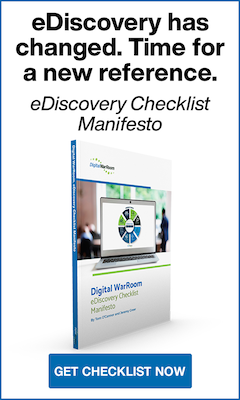In 2010, noted e-discovery consultant Craig Ball wrote a fascinating article in Law Technology News entitled "E-Discovery for Everybody." That column came to be known as the "Edna Challenge" because in it, Craig posited a solo practitioner named Edna with an e-discovery budget of $1,000 and asked how she could possibly perform any e-discovery on that amount.
The problem as Craig defined it was simple:
“The vast majority of cases filed, developed and tried in the United States are not multimillion-dollar dust ups between big companies. The evidence in modest cases is digital, too. Solo and small firm counsel like Edna need affordable, user-friendly tools designed for desktop e-discovery -- tools that preserve metadata, offer efficient workflow and ably handle the common file formats that account for nearly all of the ESI seen in day-to-day litigation. “
I first spoke on the subject at the 20011 ABA TechShow with Bruce Olson, a Wisconsin attorney and former Chair of the TechShow, and we coined the issue of the Small Case Dilemma. While it is not automatically true that small cases require different tools for managing e-discovery, the fact is that small cases often mean small technology budgets. Unless your practice is sufficiently mixed with big budget cases so that you already have a full complement of litigation support tools to use, you probably don’t have the tools necessary to handle anything but the smallest e-discovery matter. And the small budget means you can’t engage an outside consultant or vendor.
But the e-discovery rules at both the federal and state level do not apply to just large cases. They force civil litigants into a compliance mode with respect to the retention and management of electronically stored information or ESI. The risks that litigants face as a result of improper management of ESI can include findings of spoliation of evidence, summary judgment findings and sanctions, including adverse inferences, adverse jury instructions and even complaints filed with state bar associations.
There are several basic assumptions we should point out about small cases. First, we assume that you will be working with copies of live data in native format. It is also assumed that the types of files you are dealing with are typically files created by common programs used for email, word processing and other office functions. The more unique the file formats, the more likely it is that you need a higher-end solution.
Another assumption is that you want to work with the data yourself and that you have the equipment and skills to do so. There are many good Internet based hosted solutions that can fill your needs, and costs for them vary widely. However, the typical storage fees charged for a case that exists for any length of time can bust a modest technology budget. So small cases demand applications that can be installed on one computer for processing and review. Typical examples would be files burned to CD or DVD, or produced on an external storage device like a thumb drive or external hard drive.
We’re also assuming you are not dealing with terabytes of information. Small cases typically involve smaller volumes of ESI. And finally, we’re assuming you have a cooperative relationship with the other side, at least in terms of dealing with e-discovery. The single most effective way to keep e-discovery costs low is to work with your opposition in a cooperative manner so you can stipulate to the use of low cost solutions.
The question then becomes, is there really a way to process and review a couple of hundred GB of data for a reasonable price? Are there really low cost but technically adept applications that attorneys can use themselves to host and review that same data? And if not, why?
The first barrier has been the traditional pricing models in the e-discovery market. Why is this? Because many, if not most, e-discovery vendors have their roots in the per unit commodity pricing days of photocopying and imaging. The standard practice for years now has been to charge hundreds of dollars per GB each time data is handled.
The result is that at each step of the EDRM process, an exorbitant per GB price is charged. $X per GB for processing, $X per page for OCR, $X per document for near duplicate detection, $X per page for Bates numbers, $X per user and per GB to host and so on. Each step is performed for different units (GB, page, document, user, etc) with different unit pricing that can run from a penny to $500 per unit.
The result was that a forensically sound forensic collection of 800 GB (the size of the hard drive of one typical computer) typically yielded about 200 GB of reviewable material, for which a standard charge would be $200 per GB for the processing ($160,000) plus $50 per month per GB ($10,000) and $90 per month per user for the hosting. If the case lasts 18 months, this cost alone will be just under $350,000.00. And if we accept the commonly cited statistic that the review process will account for 60-70% of the total project price, then we're looking at a project cost that will eventually be close to $1,000,000.00
For 200 GB of data!
Users balked at these prices, but large e-discovery companies had no interest in lowering prices because they had high overhead costs and needed large revenue amounts to support that infrastructure. Companies with revenue streams based on processing or hosting terabytes of data cannot easily adapt to projects consisting of several hundred gigabytes much as you cannot expect a 747 jumbo jet to be used as an effective or cost efficient means of transporting commuters during rush hour traffic.
Additionally, their technology was often developed initially for large cases with large data sets. Products that have been designed to work with immense data collections cannot easily scale down to small sets of information. A Sequel based product working with terabytes of data on a distributed internet framework needs a certain hardware and software infrastructure to operate and simply can’t be scaled down to load on a laptop or tablet.
When this cost is added to the legacy mind set of unitized pricing noted above, these vendors are locked into a system of set monthly costs and simply cannot, from their perspective, give away their services to small firms with small cases.
As a result, a simple license plus annual maintenance or a monthly subscription fee model for e-discovery products simply didn’t exist. Instead, users were forced to sort through hundreds of products priced by varying and often widely divergent pricing methods.
That’s the bad news. The good news is that low-cost programs designed for small cases do, in fact, exist. New pricing paradigms and lower technology costs have driven a new breed of e-discovery software that is not only modestly priced but structured in such a way as to allow precise budgeting and cost calculations for their use.
The purpose of this work is to show you how that process has evolved and how you can deal with it, using Digital War Room as an example of how to proceed.
-1.png?width=400&height=164&name=DWRLogoClassic%20-%20Copy%20(2)-1.png)









Comment On This Article